Marlene Dietrich (1901-1992) was the first German actress who became successful in Hollywood. Throughout her long career, she constantly re-invented herself. In 1920s Berlin, she started as a cabaret singer, chorus girl and film actress. In the 1930s, she became a Hollywood star, then a World War II frontline entertainer, and finally she was an international stage show performer from the 1950s till the 1970s. Now we remember her as one of the icons of the 20th century.
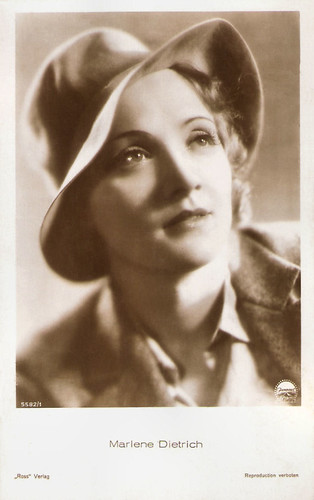
German postcard by Ross Verlag, no. 5582/1, 1930-1931. Photo: Paramount.
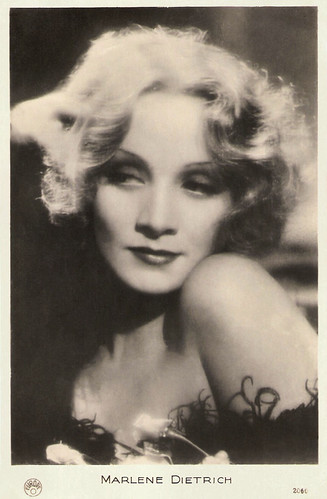
French postcard by Europe, no. 2060. Photo: Paramount. Publicity still for Shanghai Express (Josef von Sternberg, 1932).
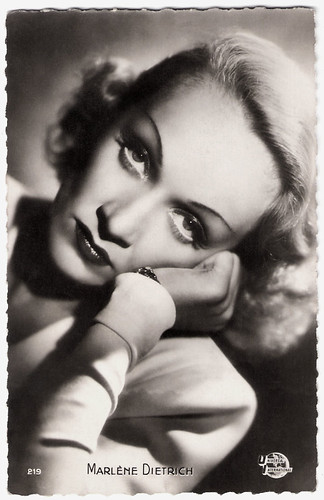
French postcard by Editions P.I., presented by NV Victoria, Brussels, no. 219. Photo: Universal International.
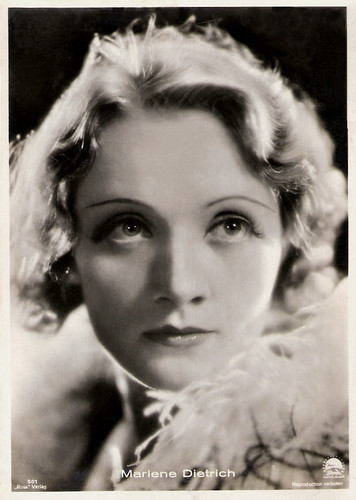
German postcard by Ross Verlag, no. 501. Photo: Paramount. Publicity still for Morocco (Josef von Sternberg, 1930).

German postcard by Ross Verlag, no. 545. Photo: Paramount.
Marie Magdalene Dietrich was born in Berlin-Schöneberg, Germany, in 1901. She was the younger of two daughters of Louis Erich Otto Dietrich and Wilhelmina Elisabeth Josephine née Felsing.
Her mother was from a well-to-do Berlin family who owned a clock making firm and her father was a police lieutenant. He died in 1911. His best friend, Eduard von Losch, an aristocrat first lieutenant in the Grenadiers courted Wilhelmina and eventually married her in 1916. He was killed on the Russian front in 1918.
The young Marie Magdalene and her elder sister, Elisabeth, were brought up strictly in an upper-middle-class Prussian home. It would be this influence which would shape her acting career and her life as a citizen in years to come.
Dietrich attended school in Berlin and Dessau from 1907 to 1919. She studied violin and became interested in theatre and poetry as a teenager. Her dreams of becoming a concert violinist were cut short when she injured her wrist.
In 1921, she auditioned unsuccessfully for Max Reinhardt's drama academy, but she soon found herself working in his theatres as a chorus girl and playing small roles in dramas.
The next year she played a part in the silent film So sind die Männer/The Little Napoleon (Georg Jacoby, 1922). On the set of another film, Tragödie der Liebe/The Tragedy of Love (Joe May, 1923), she met production assistant Rudolf Sieber. They were married in 1923. Her only child, daughter Maria Elisabeth Sieber, later billed as actress Maria Riva, was born in 1924.
Throughout the 1920s Marlene continued to work on stage and in films both in Berlin and Vienna. She attracted most attention in stage musicals and revues, such as Broadway and Es Liegt in der Luft/It's in the Air.
By the late 1920s, she was also playing leading parts in such films as Café Elektric/Cafe Electric (Gustav Ucicky, 1927) with Willi Forst, Ich küsse Ihre Hand, Madame/I Kiss Your Hand Madame (Robert Land, 1929) with Harry Liedtke, and Die Frau, nach der man sich sehnt/The Woman One Longs For (Kurt/Curtis Bernhardt, 1929) opposite Fritz Kortner.
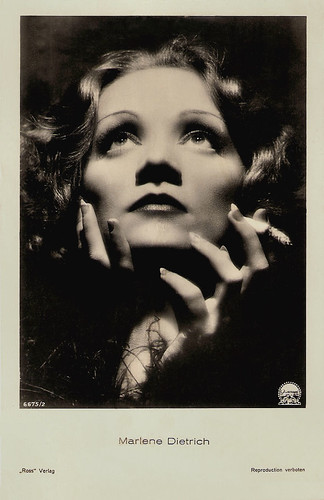
German postcard by Ross Verlag, no. 6673/2, 1931-1932. Photo: Don English / Paramount. Publicity still for Shanghai Express (Josef von Sternberg, 1932).
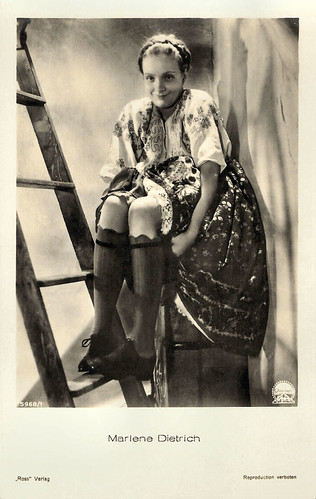
German postcard by Ross Verlag, no. 5968/1, 1930-1931. Photo: Paramount. Marlene Dietrich in the film Dishonored/Agent X27 (Josef von Sternberg, 1931).
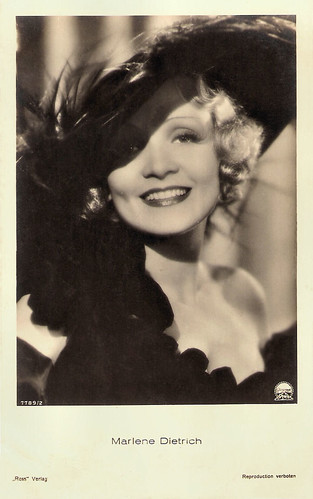
German postcard by Ross Verlag, no. 7789/2, 1932-1933. Photo: Paramount. Marlene Dietrich in the film The Song of Songs (Rouben Mamoulian, 1933).

German postcard by Ross Verlag, no. 8709/1, 1933-1934. Photo: Paramount. Publicity still for The Scarlet Empress (Josef von Sternberg, 1934) with Gavin Gordon.
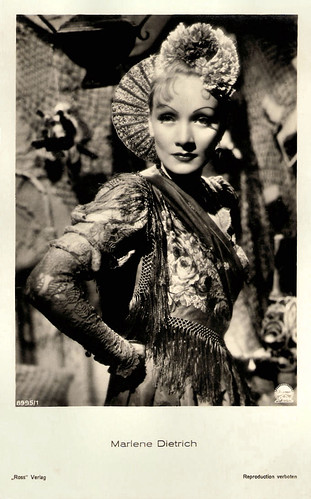
German postcard by Ross Verlag, no. 8995/1, 1933-1934. Photo: Paramount. Publicity still for The Devil Is a Woman (Josef von Sternberg, 1935).
In 1929 Marlene Dietrich played her breakthrough role of Lola-Lola, a cabaret singer who causes the downfall of Immanuel Rath (Emil Jannings), a hitherto respected schoolmaster, in the Ufa production Der blaue Engel/The Blue Angel (Josef von Sternberg, 1930).
Josef von Sternberg thereafter took credit for having ‘discovered’ her. The film is also noteworthy for introducing her signature song Falling in Love Again. On the strength of Der blaue Engel's success, and with encouragement and promotion from Von Sternberg, Dietrich then moved to Hollywood. She left her husband and daughter behind.
Paramount sought to market her as a German answer to MGM's Swedish sensation Greta Garbo. Her first American film, Morocco (Josef von Sternberg, 1930) opposite Gary Cooper earned her her only Oscar nomination.
Between 1930 and 1935 she was the star of six films directed by von Sternberg at Paramount: Morocco (1930); Dishonored (1931), about a spy who betrays her country for love of a worthless man (Victor McLaglen); Shanghai Express (1932), a melodrama in which she is a China Coast prostitute who offers herself to a warlord (Warner Oland) to save the life of a former lover (Clive Brook); Blonde Venus (1932), a mother-love soap opera;, The Scarlet Empress (1934), an opulent and visually stunning melodrama about a lascivious Catherine the Great; and The Devil Is A Woman (1935), an erotic tale about a soldier-corrupting vamp in turn-of-the-century Seville.
Wikipedia describes how Von Sternberg worked very effectively with Dietrich to create the image of a glamorous femme fatale: "He encouraged her to lose weight and coached her intensively as an actress – she, in turn, was willing to trust him and follow his sometimes imperious direction in a way that a number of other performers resisted. A crucial part of the overall effect was created by Von Sternberg's exceptional skill in lighting and photographing Dietrich to optimum effect — the use of light and shadow, including the impact of light passed through a veil or slatted blinds (as for example in Shanghai Express) — which, when combined with scrupulous attention to all aspects of set design and costumes, make this series of films among the most visually stylish in cinema history."
Because it displayed her beauty most effectively, The Devil Is a Woman was her particular favourite. But after the dismal failure of The Devil Is A Woman, Paramount fired Von Sternberg, and the star and director would never work together again.

French postcard by EDUG, no. 1073. Photo: Paramount. Publicity still for Blonde Venus (Josef von Sternberg, 1932).
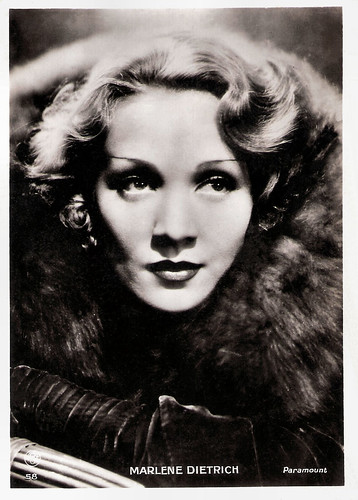
French postcard by Europe, no. 58. Photo: Paramount. Publicity still for Shanghai Express (Josef von Sternberg, 1932).
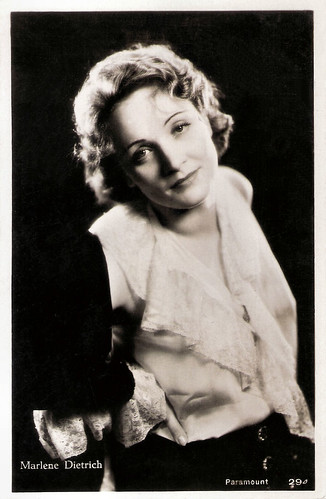
Dutch postcard, no. 294. Photo: Paramount.
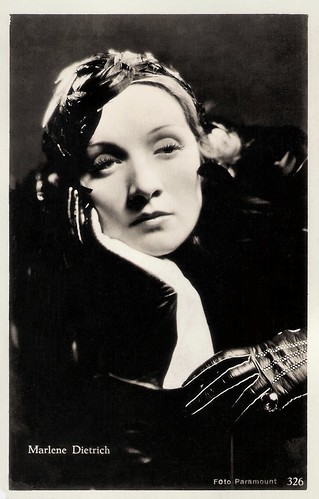
Dutch postcard, no. 326. Sent by mail in the Netherlands in 1934. Photo: Paramount. Publicity still for Shanghai Express (Josef von Sternberg, 1932).
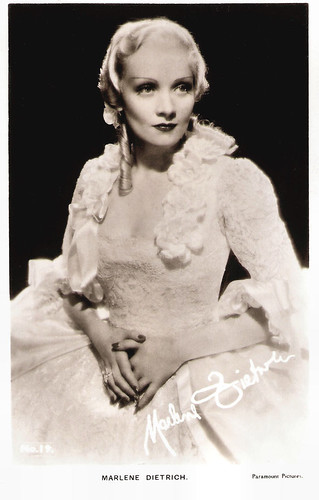
British postcard by Film-Kurier Series, London, no. 19. Photo: Paramount Pictures. Publicity still for The Scarlet Empress (Josef von Sternberg, 1934).
Without Von Sternberg, Marlene Dietrich made her first comedy, Desire (Frank Borzage, 1936). It was a satire about an urbane jewel thief (Dietrich) who steals a choice necklace from a Parisian jeweller and, in efforts to keep it, becomes involved with a hayseed Detroit engineer (Gary Cooper).
Although Dietrich's salary in the mid 1930s was enormous, she was never listed among the top ten box-office attractions, and depression-era audiences often felt she was preposterously exotic. She was even labelled 'box office poison' after Knight Without Armour (Jacques Feyder, 1937) proved an expensive flop.
In 1939, her stardom revived when she played the freewheeling saloon entertainer Frenchie in the comic Western Destry Rides Again (George Marshall, 1939) opposite James Stewart. Hollywood's attempt to make her more 'ordinary' worked. The film also introduced another favourite song, The Boys in the Back Room.
She played a similar role with John Wayne in The Spoilers (Ray Enright, 1942).
In December 1941, the US had entered World War II, and Dietrich became one of the first celebrities to raise war bonds. She toured the US from January 1942 to September 1943 and it is said that she sold more war bonds than any other star. During two extended tours for the USO in 1944 and 1945, she sang and performed the singing saw for Allied troops on the front lines in Algeria, Italy, England and France.
For musical propaganda broadcasts designed to demoralize enemy soldiers, she recorded a number of songs in German, including the ballad Lili Marleen. The troops loved her.
In 1947, she was awarded the Presidential Medal of Freedom by the US for her wartime work. In 1950, the French state conferred the title of Chevalier de la Légion d' Honneur (knight of the Legion of Honour) on her, in 1971 she was named Officier by President Pompidou and in 1989 Commandeur by President Mitterrand.

British postcard, distributed in the Netherlands by M. Bonnist & Zonen, Amsterdam, no. 136e. Photo: Paramount. Publicity still for Blonde Venus (Josef von Sternberg, 1932) with Dickie Moore.
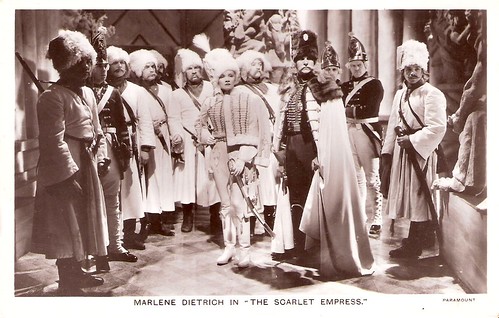
British-Dutch postcard by M. Bonnist & Zonen, Amsterdam, no. B 351. Photo: Paramount. Publicity still for The Scarlet Empress (Josef von Sternberg, 1934) with Marlene Dietrich as Catherine the Great, the notorious empress of Russia.
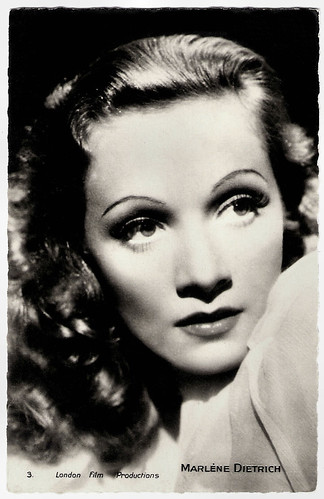
French postcard by Editions Chantal, Rueil, no. 3. Photo: London Film Productions. Publicity still for Knight Without Armour (Jacques Feyder, 1937).

German postcard by Ross Verlag, no. 9906/4, 1935-1936. Photo: London Film Productions. Marlene Dietrich in the film Knight Without Armour (Jacques Feyder, 1937).
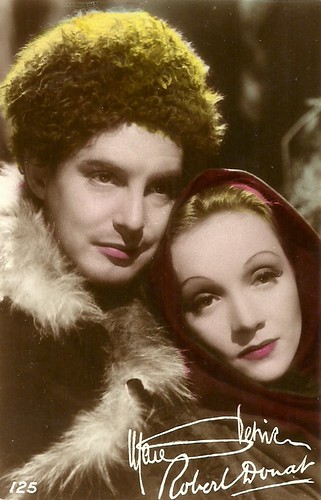
British postcard by Art Photo Postcard, no. 125. Marlene Dietrich and Robert Donat in the London Films production Knight Without Armour (Jacques Feyder, 1937).
From the early 1950s until the mid-1970s, Marlene Dietrich worked almost exclusively as a highly-paid cabaret artist, performing live in large theatres in major cities worldwide. Her costumes (body-hugging dresses covered with thousands of crystals as well as a swansdown coat), body-sculpting undergarments, careful stage lighting helped to preserve Dietrich's glamorous image well into old age.
She never fully regained her former screen glory, but she continued performing in films for distinguished directors. Her successful film roles included an exotic gypsy in Golden Earrings (Mitchell Leisen, 1947), with Ray Milland, an ex-Nazi cafe singer in A Foreign Affair (Billy Wilder, 1948), a famous singer and murderer in Stage Fright (Alfred Hitchcock, 1950), an aging bandit queen in Rancho Notorious (Fritz Lang, 1952), the wife of a suspected murderer in Witness for the Prosecution (Billy Wilder, 1957), a cynical brothel-keeper in Touch of Evil (Orson Welles, 1958), and the aristocratic widow of a prominent Nazi general in Judgment at Nuremberg (Stanley Kramer, 1961).
Dietrich's show business career largely ended in 1975, when she broke her leg during a stage performance in Sydney, Australia. Her husband, Rudolf Sieber, died of cancer in 1976. Her final on-camera film appearance was a small role in Schöner Gigolo, armer Gigolo/Just a Gigolo (David Hemmings, 1979), starring David Bowie.
Dietrich withdrew to her apartment in Paris. She spent the final 11 years of her life mostly bedridden, allowing only a select few — including family and employees — to enter the apartment. During this time, she was a prolific letter-writer and phone-caller. Her autobiography, Nehmt nur mein Leben/Marlene, was published in 1979.
In 1982, she agreed to participate in a documentary film about her life, Marlene (1984), but refused to be filmed. The film's director, Maximilian Schell, was only allowed to record her voice. He used his interviews with her as the basis for the film, set to a collage of film clips from her career. The final film won several European film prizes and received an Academy Award nomination for Best Documentary in 1984. Newsweek named it "a unique film, perhaps the most fascinating and affecting documentary ever made about a great movie star".
In 1992, Marlene Dietrich died of renal failure at the age of 90 in Paris. Ten years after her death, Berlin - the city of Dietrich's birth which she shunned for most of her life - declared her an honorary citizen.
In a 1992 obituary The New York Times wrote: "In her films and record-breaking cabaret performances, Miss Dietrich artfully projected cool sophistication, self-mockery and infinite experience. Her sexuality was audacious, her wit was insolent and her manner was ageless. With a world-weary charm and a diaphanous gown showing off her celebrated legs, she was the quintessential cabaret entertainer of Weimar-era Germany."

French postcard by Editions P.I., no. 219.
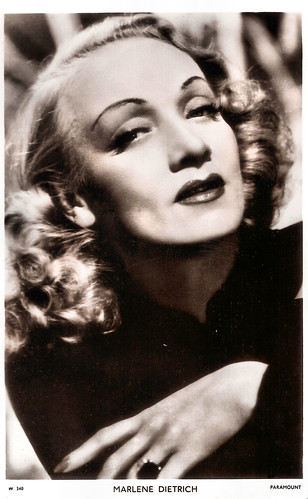
British postcard in the Picturegoer series, London, no. W 340. Photo: Paramount.
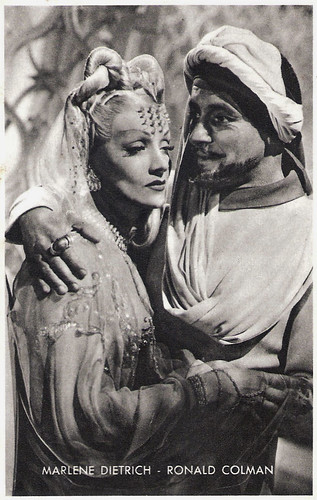
Belgian collectors card by Kwatta, Bois d'Haine, no. C 156. Photo: M.G.M. Publicity still for Kismet (William Dieterle, 1944) with Ronald Colman.

American postcard by Quantity Postcards, Oakland, no. 3372.
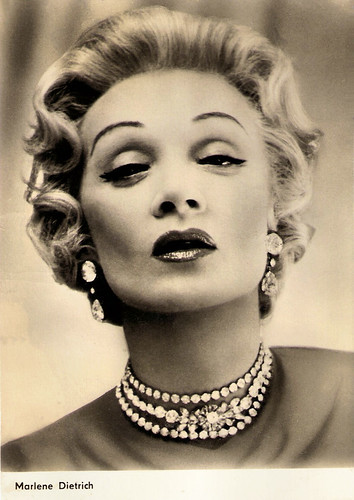
East-German postcard by VEB Progress Filmvertrieb, no. 2.192, 1964.
Marlene Dietrich sings Falling in love again in the English version of Der blaue Engel/The Blue Angel (Josef von Sternberg, 1930). Source: EdmundusRex (YouTube).
Sources: James Naremore (Senses of Cinema), Wikipedia, The New York Times, Marlene Dietrich Collection Berlin, and IMDb.

German postcard by Ross Verlag, no. 5582/1, 1930-1931. Photo: Paramount.

French postcard by Europe, no. 2060. Photo: Paramount. Publicity still for Shanghai Express (Josef von Sternberg, 1932).

French postcard by Editions P.I., presented by NV Victoria, Brussels, no. 219. Photo: Universal International.

German postcard by Ross Verlag, no. 501. Photo: Paramount. Publicity still for Morocco (Josef von Sternberg, 1930).

German postcard by Ross Verlag, no. 545. Photo: Paramount.
Chorus Girl
Marie Magdalene Dietrich was born in Berlin-Schöneberg, Germany, in 1901. She was the younger of two daughters of Louis Erich Otto Dietrich and Wilhelmina Elisabeth Josephine née Felsing.
Her mother was from a well-to-do Berlin family who owned a clock making firm and her father was a police lieutenant. He died in 1911. His best friend, Eduard von Losch, an aristocrat first lieutenant in the Grenadiers courted Wilhelmina and eventually married her in 1916. He was killed on the Russian front in 1918.
The young Marie Magdalene and her elder sister, Elisabeth, were brought up strictly in an upper-middle-class Prussian home. It would be this influence which would shape her acting career and her life as a citizen in years to come.
Dietrich attended school in Berlin and Dessau from 1907 to 1919. She studied violin and became interested in theatre and poetry as a teenager. Her dreams of becoming a concert violinist were cut short when she injured her wrist.
In 1921, she auditioned unsuccessfully for Max Reinhardt's drama academy, but she soon found herself working in his theatres as a chorus girl and playing small roles in dramas.
The next year she played a part in the silent film So sind die Männer/The Little Napoleon (Georg Jacoby, 1922). On the set of another film, Tragödie der Liebe/The Tragedy of Love (Joe May, 1923), she met production assistant Rudolf Sieber. They were married in 1923. Her only child, daughter Maria Elisabeth Sieber, later billed as actress Maria Riva, was born in 1924.
Throughout the 1920s Marlene continued to work on stage and in films both in Berlin and Vienna. She attracted most attention in stage musicals and revues, such as Broadway and Es Liegt in der Luft/It's in the Air.
By the late 1920s, she was also playing leading parts in such films as Café Elektric/Cafe Electric (Gustav Ucicky, 1927) with Willi Forst, Ich küsse Ihre Hand, Madame/I Kiss Your Hand Madame (Robert Land, 1929) with Harry Liedtke, and Die Frau, nach der man sich sehnt/The Woman One Longs For (Kurt/Curtis Bernhardt, 1929) opposite Fritz Kortner.

German postcard by Ross Verlag, no. 6673/2, 1931-1932. Photo: Don English / Paramount. Publicity still for Shanghai Express (Josef von Sternberg, 1932).

German postcard by Ross Verlag, no. 5968/1, 1930-1931. Photo: Paramount. Marlene Dietrich in the film Dishonored/Agent X27 (Josef von Sternberg, 1931).

German postcard by Ross Verlag, no. 7789/2, 1932-1933. Photo: Paramount. Marlene Dietrich in the film The Song of Songs (Rouben Mamoulian, 1933).

German postcard by Ross Verlag, no. 8709/1, 1933-1934. Photo: Paramount. Publicity still for The Scarlet Empress (Josef von Sternberg, 1934) with Gavin Gordon.

German postcard by Ross Verlag, no. 8995/1, 1933-1934. Photo: Paramount. Publicity still for The Devil Is a Woman (Josef von Sternberg, 1935).
Lola-Lola
In 1929 Marlene Dietrich played her breakthrough role of Lola-Lola, a cabaret singer who causes the downfall of Immanuel Rath (Emil Jannings), a hitherto respected schoolmaster, in the Ufa production Der blaue Engel/The Blue Angel (Josef von Sternberg, 1930).
Josef von Sternberg thereafter took credit for having ‘discovered’ her. The film is also noteworthy for introducing her signature song Falling in Love Again. On the strength of Der blaue Engel's success, and with encouragement and promotion from Von Sternberg, Dietrich then moved to Hollywood. She left her husband and daughter behind.
Paramount sought to market her as a German answer to MGM's Swedish sensation Greta Garbo. Her first American film, Morocco (Josef von Sternberg, 1930) opposite Gary Cooper earned her her only Oscar nomination.
Between 1930 and 1935 she was the star of six films directed by von Sternberg at Paramount: Morocco (1930); Dishonored (1931), about a spy who betrays her country for love of a worthless man (Victor McLaglen); Shanghai Express (1932), a melodrama in which she is a China Coast prostitute who offers herself to a warlord (Warner Oland) to save the life of a former lover (Clive Brook); Blonde Venus (1932), a mother-love soap opera;, The Scarlet Empress (1934), an opulent and visually stunning melodrama about a lascivious Catherine the Great; and The Devil Is A Woman (1935), an erotic tale about a soldier-corrupting vamp in turn-of-the-century Seville.
Wikipedia describes how Von Sternberg worked very effectively with Dietrich to create the image of a glamorous femme fatale: "He encouraged her to lose weight and coached her intensively as an actress – she, in turn, was willing to trust him and follow his sometimes imperious direction in a way that a number of other performers resisted. A crucial part of the overall effect was created by Von Sternberg's exceptional skill in lighting and photographing Dietrich to optimum effect — the use of light and shadow, including the impact of light passed through a veil or slatted blinds (as for example in Shanghai Express) — which, when combined with scrupulous attention to all aspects of set design and costumes, make this series of films among the most visually stylish in cinema history."
Because it displayed her beauty most effectively, The Devil Is a Woman was her particular favourite. But after the dismal failure of The Devil Is A Woman, Paramount fired Von Sternberg, and the star and director would never work together again.

French postcard by EDUG, no. 1073. Photo: Paramount. Publicity still for Blonde Venus (Josef von Sternberg, 1932).

French postcard by Europe, no. 58. Photo: Paramount. Publicity still for Shanghai Express (Josef von Sternberg, 1932).

Dutch postcard, no. 294. Photo: Paramount.

Dutch postcard, no. 326. Sent by mail in the Netherlands in 1934. Photo: Paramount. Publicity still for Shanghai Express (Josef von Sternberg, 1932).

British postcard by Film-Kurier Series, London, no. 19. Photo: Paramount Pictures. Publicity still for The Scarlet Empress (Josef von Sternberg, 1934).
Box Office Poison
Without Von Sternberg, Marlene Dietrich made her first comedy, Desire (Frank Borzage, 1936). It was a satire about an urbane jewel thief (Dietrich) who steals a choice necklace from a Parisian jeweller and, in efforts to keep it, becomes involved with a hayseed Detroit engineer (Gary Cooper).
Although Dietrich's salary in the mid 1930s was enormous, she was never listed among the top ten box-office attractions, and depression-era audiences often felt she was preposterously exotic. She was even labelled 'box office poison' after Knight Without Armour (Jacques Feyder, 1937) proved an expensive flop.
In 1939, her stardom revived when she played the freewheeling saloon entertainer Frenchie in the comic Western Destry Rides Again (George Marshall, 1939) opposite James Stewart. Hollywood's attempt to make her more 'ordinary' worked. The film also introduced another favourite song, The Boys in the Back Room.
She played a similar role with John Wayne in The Spoilers (Ray Enright, 1942).
In December 1941, the US had entered World War II, and Dietrich became one of the first celebrities to raise war bonds. She toured the US from January 1942 to September 1943 and it is said that she sold more war bonds than any other star. During two extended tours for the USO in 1944 and 1945, she sang and performed the singing saw for Allied troops on the front lines in Algeria, Italy, England and France.
For musical propaganda broadcasts designed to demoralize enemy soldiers, she recorded a number of songs in German, including the ballad Lili Marleen. The troops loved her.
In 1947, she was awarded the Presidential Medal of Freedom by the US for her wartime work. In 1950, the French state conferred the title of Chevalier de la Légion d' Honneur (knight of the Legion of Honour) on her, in 1971 she was named Officier by President Pompidou and in 1989 Commandeur by President Mitterrand.

British postcard, distributed in the Netherlands by M. Bonnist & Zonen, Amsterdam, no. 136e. Photo: Paramount. Publicity still for Blonde Venus (Josef von Sternberg, 1932) with Dickie Moore.

British-Dutch postcard by M. Bonnist & Zonen, Amsterdam, no. B 351. Photo: Paramount. Publicity still for The Scarlet Empress (Josef von Sternberg, 1934) with Marlene Dietrich as Catherine the Great, the notorious empress of Russia.

French postcard by Editions Chantal, Rueil, no. 3. Photo: London Film Productions. Publicity still for Knight Without Armour (Jacques Feyder, 1937).

German postcard by Ross Verlag, no. 9906/4, 1935-1936. Photo: London Film Productions. Marlene Dietrich in the film Knight Without Armour (Jacques Feyder, 1937).

British postcard by Art Photo Postcard, no. 125. Marlene Dietrich and Robert Donat in the London Films production Knight Without Armour (Jacques Feyder, 1937).
Body-hugging Dresses and careful stage lighting
From the early 1950s until the mid-1970s, Marlene Dietrich worked almost exclusively as a highly-paid cabaret artist, performing live in large theatres in major cities worldwide. Her costumes (body-hugging dresses covered with thousands of crystals as well as a swansdown coat), body-sculpting undergarments, careful stage lighting helped to preserve Dietrich's glamorous image well into old age.
She never fully regained her former screen glory, but she continued performing in films for distinguished directors. Her successful film roles included an exotic gypsy in Golden Earrings (Mitchell Leisen, 1947), with Ray Milland, an ex-Nazi cafe singer in A Foreign Affair (Billy Wilder, 1948), a famous singer and murderer in Stage Fright (Alfred Hitchcock, 1950), an aging bandit queen in Rancho Notorious (Fritz Lang, 1952), the wife of a suspected murderer in Witness for the Prosecution (Billy Wilder, 1957), a cynical brothel-keeper in Touch of Evil (Orson Welles, 1958), and the aristocratic widow of a prominent Nazi general in Judgment at Nuremberg (Stanley Kramer, 1961).
Dietrich's show business career largely ended in 1975, when she broke her leg during a stage performance in Sydney, Australia. Her husband, Rudolf Sieber, died of cancer in 1976. Her final on-camera film appearance was a small role in Schöner Gigolo, armer Gigolo/Just a Gigolo (David Hemmings, 1979), starring David Bowie.
Dietrich withdrew to her apartment in Paris. She spent the final 11 years of her life mostly bedridden, allowing only a select few — including family and employees — to enter the apartment. During this time, she was a prolific letter-writer and phone-caller. Her autobiography, Nehmt nur mein Leben/Marlene, was published in 1979.
In 1982, she agreed to participate in a documentary film about her life, Marlene (1984), but refused to be filmed. The film's director, Maximilian Schell, was only allowed to record her voice. He used his interviews with her as the basis for the film, set to a collage of film clips from her career. The final film won several European film prizes and received an Academy Award nomination for Best Documentary in 1984. Newsweek named it "a unique film, perhaps the most fascinating and affecting documentary ever made about a great movie star".
In 1992, Marlene Dietrich died of renal failure at the age of 90 in Paris. Ten years after her death, Berlin - the city of Dietrich's birth which she shunned for most of her life - declared her an honorary citizen.
In a 1992 obituary The New York Times wrote: "In her films and record-breaking cabaret performances, Miss Dietrich artfully projected cool sophistication, self-mockery and infinite experience. Her sexuality was audacious, her wit was insolent and her manner was ageless. With a world-weary charm and a diaphanous gown showing off her celebrated legs, she was the quintessential cabaret entertainer of Weimar-era Germany."

French postcard by Editions P.I., no. 219.

British postcard in the Picturegoer series, London, no. W 340. Photo: Paramount.

Belgian collectors card by Kwatta, Bois d'Haine, no. C 156. Photo: M.G.M. Publicity still for Kismet (William Dieterle, 1944) with Ronald Colman.

American postcard by Quantity Postcards, Oakland, no. 3372.

East-German postcard by VEB Progress Filmvertrieb, no. 2.192, 1964.
Marlene Dietrich sings Falling in love again in the English version of Der blaue Engel/The Blue Angel (Josef von Sternberg, 1930). Source: EdmundusRex (YouTube).
Sources: James Naremore (Senses of Cinema), Wikipedia, The New York Times, Marlene Dietrich Collection Berlin, and IMDb.
No comments:
Post a Comment